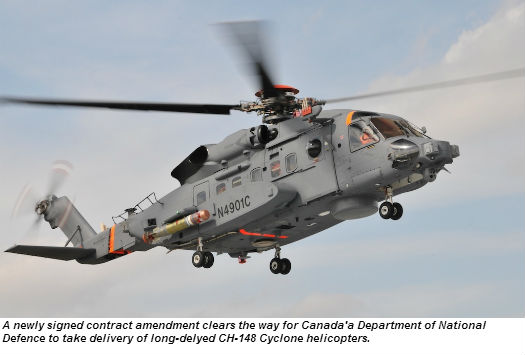
The Royal Canadian Air Force (RCAF) evidently is back on track, albeit decades behind schedule, to replace its 50-year-old Sikorsky CH-124 Sea Kings with CH-148 Cyclones, a version of Sikorsky’s H-92 Superhawk. Announced June 18, the development was made possible by amendments to the $1.9-billion capital acquisition contract and the $5.7-billion long-term in-service support contract, which has been extended by 10 years to 2038.
Sikorsky’s parent company, United Technologies Corp., and the Canadian government issued terse statements to the effect that the RCAF would begin taking delivery of 28 “operationally relevant” Cyclones. According to a Sikorsky spokesperson, this means the RCAF will have helicopters capable of conducting the training and missions required of them. For example, Block 1 aircraft will be suitable for release to operational service, including search and rescue and utility transport. In early 2016, the spokesperson said, as enhancements are completed, the aircraft will be suitable for limited anti-submarine and anti-surface warfare missions such as those requiring the use of weapons in a threat environment.
“In its final configuration, the CH-148 Cyclone will be one of the most capable maritime helicopters in the world, and at the forefront of modern technology,” PWGSC and DND said in their statement. “It will be capable of a full range of search and rescue and utility missions in challenging environments.” It also would be “fully interoperable in a modern battle space, and will be able to concurrently conduct a full spectrum of anti-submarine warfare and anti-surface warfare in hostile, high-threat environments.”
The need for Sea King replacement was initially identified in the early 1980s, setting the stage for a New Shipborne Aircraft (NSA) project announced in 1986. The 35 helicopters were to be the “eyes and ears” of the navy’s 12 new frigates. However, in 1991, the NSA project was merged with a requirement for 15 search-and-rescue helicopters.
That led to the selection of the AgustaWestland EH-101 at a cost of $5.8 billion but the Progressive Conservative government, faced with widespread criticism, reduced the total buy to 43 aircraft and the budget to $4.8 billion. That administration was unseated by the Liberals in 1993 and the new prime minister, Jean Chretien, cancelled the program, dismissing the EH-101 as “a Cadillac-type helicopter that is not needed because it is not based on the new reality of the Cold War being over.”
A 1994 Defence White Paper resurrected the need for new shipborne and SAR helicopters and the latter need was eventually filled in 1998 when the government opted, ironically, for the EH-101, now operating as the RCAF’s CH-149 Cormorants.
The government rebadged the NSA as the Maritime Helicopter Project and, in the process, senior DND officials indicated that they wanted a reduced combat capability. In 2000, then-Defence Minister Art Eggleton said DND would get “helicopters that are more suited to the post-Cold War era where the majority of missions are expected to be along the coast” rather than a deep-water anti-submarine role.
Eventually contracted to Sikorsky, the MHP contract has since been fraught with problems, mainly due to the government refining the mission requirements on what was supposed to be an “off the shelf” helicopter. There also were issues with, among other things, engine power, vibration and mission systems.
The upshot was that Sikorsky eventually supplied several “interim” Cyclones, which remained the company’s property even as the RCAF at its base in Shearwater, N.S., used them mainly for non-flying training. In December, Public Works and Government Services Minister Diane Finley confirmed that the government was “in discussions with Sikorsky” to determine “if we can put together a plan to go forward.”









